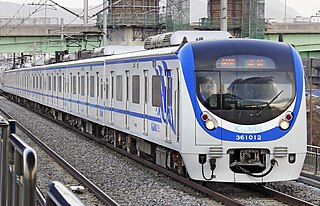
The Gyeongchun Line is a regional rail line between Seoul and Chuncheon, South Korea, operated by Korail. Its name is derived from Gyeong and Chuncheon. It was completely reconstructed in the 2000s. Service on it has operated between Sangbong station on the Jungang Line in eastern Seoul and Chuncheon station, as part of the Seoul Metropolitan Subway system, since December 21, 2010. A class of regional rail service named ITX-Cheongchun began operations on February 28, 2012, linking Chuncheon to Cheongnyangni and Yongsan Stations.

The MF 77 is a steel-wheeled variant of the rolling stock used on the Paris Métro. First used in 1978, it now runs on Lines 7, 8, and 13.

The MF 2000 is a model of steel-wheeled electrical multiple units used on Paris's Metro system. The cars first arrived in December 2007 and delivery was completed in 2015. RATP ordered 160 trains or 800 cars in 2001, to replace the aging MF 67. It is used on Lines 2, 5, and 9.

For servicing suburban commuter lines, electrified on 25 kV, AC, the Railcar Manufacturing Plant of Riga produced ER9, then ER9P and other modifications of electric trainsets in the 1962-2002 period. The mass production of these trains had begun in 1964.

ER2 electric trainset is a DC electric multiple unit which was in production by the Railroad Machinery Plants of Riga from June 1962 to mid-1984. It was essentially an improvement of the ER1 design, featuring footboards for low platforms, and aprons for high platforms, as well as improved electrical equipment and minor changes to the bodywork. Since the mid-1960s, the ER2 has been the most widely used type of suburban train in the Soviet Union and its successor states.

The Tokyo Metro 08 series is an electric multiple unit (EMU) train type operated on the Tokyo Metro Hanzōmon Line in Tokyo, Japan since 2003. Introduced into service on 1 July 2003, a total of six ten-car trainsets were manufactured by Nippon Sharyo between 2002 and 2003 to augment the 8000 series trains following the extension to Oshiage.

The SNCF Class Z 20500 is a double-deck, dual-voltage electric multiple unit trainset that are operated by SNCF on the Réseau Express Régional (RER), a hybrid suburban commuter and rapid transit system and the Transilien, a suburban commuter rail system, both serving Paris and its Île-de-France suburbs.

The Korail Class 1000 was a series of electric multiple units built in Seoul, South Korea for Seoul Subway Line 1. The cars were built in and entered service between 1974 and 1997. They were gradually retired from the late 1990s to 2020 by newer electric multiple unit trains.

The Korail Class 311000 trains, some train of which were formerly identified as Korail Class 5000 trains, are commuter electric multiple units in South Korea used on Seoul Subway Line 1. Class 311000 trains were manufactured and delivered between 1996 and 2006, and again from 2012 to 2014 to expand service on the Gyeongbu Line and the Gyeongwon Line, and to replace older trains.

The KTX-Sancheon is a South Korean high-speed train built by Hyundai Rotem in the second half of the 2000s and operated by Korail since March 2009. With a top speed of 305 km/h (190 mph), the KTX-Sancheon is the second commercial high-speed train operated in South Korea and the first domestic high-speed train that is designed and developed in South Korea.
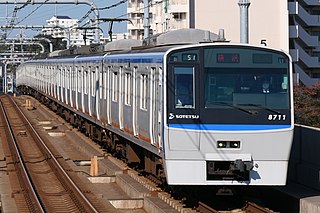
The Sotetsu 8000 series (相鉄8000系) is a DC electric multiple unit (EMU) train type operated by the private railway operator Sagami Railway (Sotetsu) in Kanagawa Prefecture, Japan, since 1990.

The Korail Class 321000 trains, created from an assortment of Class 5000, Class 6000, and new cars, are commuter electric multiple units in South Korea used on the Gyeongui-Jungang Line. Class 321000 trains were manufactured and delivered between 2006–2009 to provide service on what was known as the Jungang Line at the time, and to address progressing extensions starting from the extension to Paldang Station.

The Korail Class 331000 trains are commuter electric multiple units in South Korea used on the Gyeongui·Jungang Line. Class 331000 trains were manufactured and delivered in 2009 and from 2012 to 2014 to provide service on the Gyeongui Line and to address progressing extensions starting from the extension to Gongdeok Station.

The Korail Class 371000 trains are commuter electric multiple units in South Korea used on the Gyeonggang Line.

The Korail Class 341000 trains, formerly identified as Korail Class 2000 trains, are commuter electric multiple units in South Korea used on Seoul Subway Line 4. Class 341000 trains were manufactured and delivered between 1993 and 1999 to expand service on the Gwacheon Line and the Ansan Line sections of Line 4.
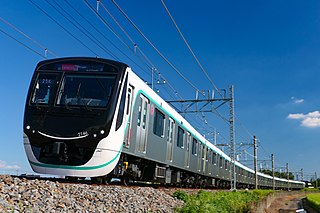
The Tokyu 2020 series is an electric multiple unit (EMU) commuter train type built by J-TREC and used by the Japanese private railway operator Tokyu Corporation in the Tokyo area since March 2018. The 2020 series is used primarily on the Tokyu Den-en-toshi Line while its derivatives, the 3020 series and the 6020 series, are used mainly on the Tokyu Meguro Line and Tokyu Oimachi Line respectively.

The Korail Class 351000 trains, formerly identified as Korail Class 2000 trains, are commuter electric multiple units in South Korea used on Suin-Bundang Line. Class 351000 trains were manufactured and delivered between 1993.
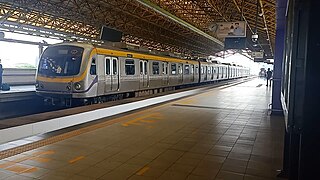
The LRTA 2000 class, also known by the Light Rail Transit Authority as the Rotem/Toshiba Megatren Model 2003, is a class of electric multiple units of the Light Rail Transit Authority (LRTA) in Metro Manila, Philippines, which began operation in 2003. It is used in Line 2.
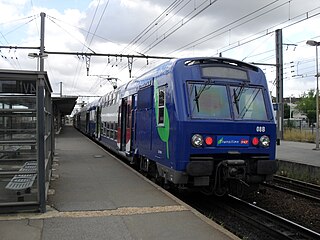
The SNCF Class Z 8800 is a double-deck, dual-voltage electric multiple unit trainset that are operated by SNCF on the Réseau Express Régional (RER), a hybrid suburban commuter and rapid transit system and the Transilien, a suburban commuter rail system, both serving Paris and its Île-de-France suburbs.

The PNR EM10000 class is an electric multiple unit commuter trainset that will be operated by the Philippine National Railways on the North–South Commuter Railway. Prior to the reveal of its numbering scheme in October 2021, the train was known as the PNR Sustina Commuter. Set to enter service by 2023, it will be PNR's first trainset to be run on standard gauge and powered by electric traction. The trains are also designed to be interoperable with the Metro Manila Subway.























